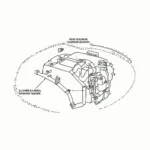The Kline OBD2 interface is a crucial component in vehicle diagnostics, providing a communication pathway between a vehicle’s electronic control units (ECUs) and diagnostic tools. This article will delve into the specifics of Kline OBD2, exploring its functionality, applications, and significance in modern automotive technology.
What is Kline OBD2?
Kline OBD2 refers to a single-wire communication protocol used in some older vehicles, typically those manufactured before 2008. It’s a simpler system compared to the more modern CAN (Controller Area Network) bus system. Kline utilizes a single wire for both data transmission and reception, operating at a slower baud rate than CAN. While less sophisticated than CAN, Kline OBD2 still provides access to valuable diagnostic information, allowing mechanics and car owners to troubleshoot issues and maintain vehicle health.
Kline OBD2 vs. CAN Bus: Key Differences
Understanding the distinctions between Kline and CAN is vital for effective vehicle diagnostics. CAN offers significantly faster data transfer rates, enabling more complex and real-time data acquisition. Furthermore, CAN is a multi-drop bus system, allowing multiple ECUs to communicate simultaneously, while Kline is a single-wire system. Choosing the right diagnostic tool and understanding the communication protocol of your vehicle is essential for accurate and efficient troubleshooting.
Applications of Kline OBD2
Despite its limitations compared to CAN, Kline OBD2 remains relevant for diagnosing a range of vehicle issues. It’s commonly used to access engine data, transmission information, and ABS system diagnostics in older vehicle models. Furthermore, Kline can be utilized for tasks like reading and clearing diagnostic trouble codes (DTCs), monitoring sensor data, and performing actuator tests.
Using a Kline OBD2 Scanner
Connecting a Kline OBD2 scanner is a straightforward process. Locate the OBD2 port, typically situated under the dashboard on the driver’s side. Plug the scanner into the port and turn the vehicle’s ignition to the “on” position without starting the engine. The scanner will then establish communication with the vehicle’s ECUs, allowing you to access diagnostic data.
Troubleshooting Common Kline OBD2 Issues
Occasionally, you may encounter communication problems when using a Kline OBD2 scanner. These issues can stem from several factors, such as a faulty OBD2 port, damaged wiring, or compatibility issues between the scanner and the vehicle. Checking the fuses related to the OBD2 system and ensuring the scanner is compatible with your vehicle’s protocol are essential troubleshooting steps.
How to Choose the Right Kline OBD2 Scanner
Selecting the appropriate Kline OBD2 scanner depends on your specific needs and budget. While basic scanners provide access to essential diagnostic data, more advanced models offer features like live data streaming, graphing capabilities, and bi-directional control. Consider your diagnostic requirements and choose a scanner that provides the functionality you need.
Conclusion
Kline OBD2 remains a valuable tool for diagnosing older vehicles. Understanding its functionality and limitations is essential for effective vehicle maintenance and repair. Choosing the right Kline OBD2 scanner and utilizing proper troubleshooting techniques can empower you to address vehicle issues efficiently and keep your car running smoothly.
FAQ
- What does Kline stand for in OBD2? K-Line stands for K-Line, a single-wire communication protocol.
- Is my car Kline or CAN? Vehicles manufactured before 2008 typically use Kline, while newer models use CAN. Consult your vehicle’s manual or use an OBD2 scanner to determine the protocol.
- Can I use a CAN scanner on a Kline car? Some CAN scanners are backward compatible with Kline, but it’s essential to check the scanner’s specifications.
- Why is my Kline OBD2 scanner not connecting? Check the OBD2 port, wiring, fuses, and scanner compatibility.
- Where can I find a reliable Kline OBD2 scanner? OBDFree offers a wide selection of high-quality OBD2 scanners, including those compatible with Kline.
- What is the baud rate of Kline OBD2? Kline typically operates at 10.4 kilobaud.
- Can I use Kline OBD2 for programming? Kline is primarily used for diagnostics, not programming.
Need further assistance? Contact our 24/7 customer support via WhatsApp: +1(641)206-8880 or Email: [email protected].


